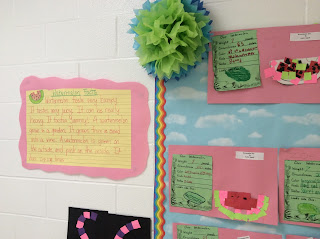Have you ever had a book that you didn't know what to do with it in your classroom? Well, if you have Watermelon Day by: Kathi Appelt... you're in luck! I'd like to share with you some activities and ideas that I've done with my first graders. My students LOVE this book and it captures their attention thru out the whole story. I use A LOT of expression when I read this book to my class and I have their full attention. I like to use this story at the beginning of the year, usually in September. This book lends itself to activities in writing, reading, math and science.
If you wanted to, you could use this story for the whole week, and read it every day and do a different activity. The possibilities are endless!
The first activity I do with my first graders is writing. We talk about tiny moment stories and how a watermelon symbolizes our tiny moments. Here is my anchor chart that I use:
 |
Or, you can have your students write a how-to story about how to grow a watermelon: |
Here's my interactive writing out in the hallway:
 |
| Interactive Writing Piece |
After the students do their craftivity, the next day we use our 5 senses to experience a watermelon. I bring in a small watermelon and we touch, smell, taste, hear, and look at it's attributes. We use a tape measure to see how many inches around it is for the circumference and we weigh it to see how many pounds it is. Last, I let them taste the watermelon. You could cut it up, or already have it cut up from home. Here is the template that I use for measuring our watermelon:
Here is the template that I use for our 5 senses:
We also talk about the life cycle of a watermelon: seeds, seedling, sprout, vine, and watermelon. We use this template to color, cut out and glue into our science notebook.
We also practice retelling the story from beginning, middle and end. I have sentence strips on my pocket chart that we put in order. Then, the students get to write or illustrate their own beginning, middle and end of the story. If you have reluctant writers at the beginning of the year...which we all have... let them just draw pictures. Or, you could scribe for them!
Linking Literature: Watermelon Day
Love,
Kara
Graphics Courtesy of:










